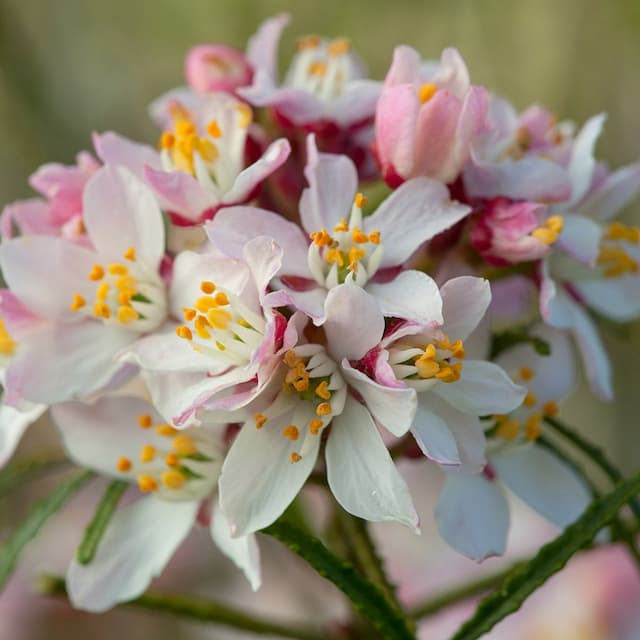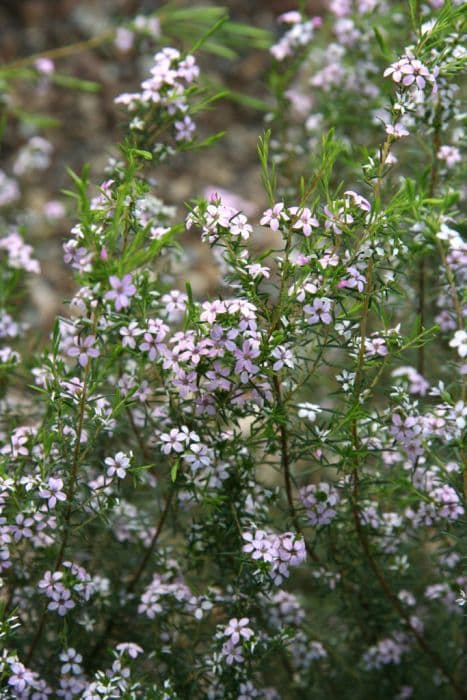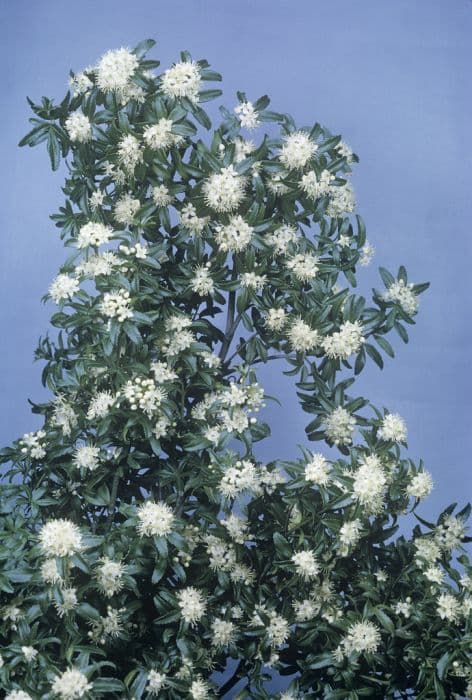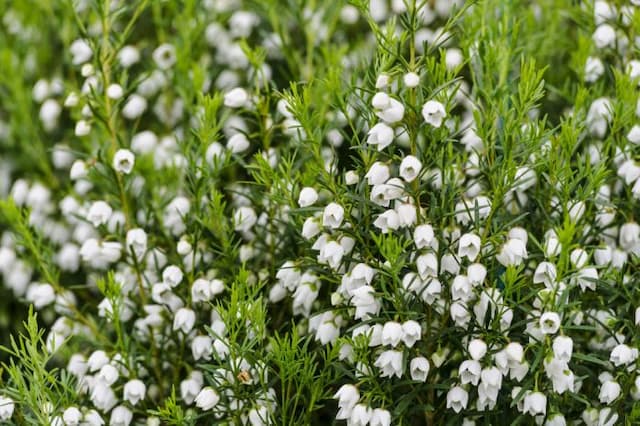Japanese Skimmia Skimmia japonica

ABOUT
Skimmia japonica, commonly known as Japanese skimmia, is an evergreen shrub that is recognized for its attractive foliage, fragrant flowers, and red berries. The plant has a dense, round, and bushy habit, which makes it an ideal choice for gardeners looking to add structure and year-round interest to their landscapes. The leaves of the Japanese skimmia are leathery with a glossy, dark green appearance. They are lance-shaped and can be quite substantial in size, providing a lush backdrop to the other elements of the plant. These leaves are arranged in a whorled pattern, which adds to the plant's visual appeal. Between late winter and early spring, the plant produces clusters of tiny flowers. The flowers are small but numerous, creating a noticeable display. They are typically white or light pink and have a sweet, sometimes heavy scent that can be quite alluring in the garden. After the flowering period, the Japanese skimmia is decorated with bright red berries, which stand out against the green foliage. These berries can last through the winter months, providing a splash of color when most other plants have died back or are dormant. The berries also attract birds to the garden, adding a layer of dynamic wildlife interaction to the setting. Through its distinct combination of ornamental leaves, aromatic flowers, and vibrant berries, Japanese skimmia maintains interest throughout all seasons, making it a valuable plant for both ornamental borders and foundation plantings where year-round beauty is desired.
About this plant
 Names
NamesFamily
Rutaceae
Synonyms
Japanese Skimmia, Japonica
Common names
Skimmia oblata, Skimmia japonica var. repens, Skimmia repens
 Toxicity
ToxicityTo humans
Skimmia japonica, commonly known as Japanese skimmia, contains compounds that are toxic to humans. These compounds, such as skimmianine, can cause symptoms if ingested, which may include vomiting, diarrhea, headaches, and dizziness. In some cases, ingestion can lead to more severe symptoms such as bradycardia or a decrease in blood pressure. It's important to seek medical attention if ingestion is suspected.
To pets
Skimmia japonica or Japanese skimmia is also toxic to pets. The toxins present in the plant can cause symptoms similar to those in humans, including vomiting, diarrhea, abdominal pain, and weakness. If a pet ingests parts of this plant, it can potentially lead to more serious conditions such as cardiac abnormalities. Immediate veterinary care is advised if a pet is known or suspected to have ingested any part of the plant.
 Characteristics
CharacteristicsLife cycle
Perennials
Foliage type
Evergreen
Color of leaves
Green
Flower color
White
Height
3-4 feet (0.9-1.2 meters)
Spread
3-4 feet (0.9-1.2 meters)
Plant type
Shrub
Hardiness zones
7
Native area
Japan
Benefits
 General Benefits
General Benefits- Aesthetic appeal: Skimmia japonica offers year-round ornamental beauty with its glossy evergreen leaves, red berries, and fragrant white flowers.
- Low maintenance: Once established, this plant is quite low maintenance, requiring minimal pruning and care to thrive.
- Drought-tolerant: It is relatively resistant to drought, making it suitable for regions with less rainfall once established.
- Shade tolerance: This plant is capable of growing in shady areas where other plants may struggle, making it ideal for understory plantings or north-facing gardens.
- Wildlife support: Its flowers are attractive to pollinators such as bees, while birds are drawn to its berries, providing food and encouraging biodiversity.
- Deer resistance: Skimmia japonica is generally not preferred by deer, which makes it suitable for gardens in areas with a high deer population.
 Medical Properties
Medical PropertiesThis plant is not used for medical purposes.
 Air-purifying Qualities
Air-purifying QualitiesThis plant is not specifically known for air purifying qualities.
 Other Uses
Other Uses- Dye production: Skimmia japonica leaves and berries can be used to produce green and yellow dyes when treated with mordants.
- Insect repellent: The strong scent of Skimmia japonica leaves is said to deter certain insects and can be used in closets or drawers.
- Floral arrangements: The berries and foliage of Skimmia japonica are often used in floral decorations, providing long-lasting color and form.
- Garden borders: Due to their compact and bushy nature, these plants are ideal for creating structured borders in gardens.
- Christmas decoration: The red berries and evergreen leaves make Skimmia japonica a popular addition to festive wreaths and table arrangements.
- Container gardening: Skimmia japonica is well-suited for pots and containers, offering structure and year-round interest on patios and balconies.
- Wildlife support: The dense foliage provides shelter for birds and small mammals, while the berries are a food source for certain bird species.
- Screening plant: The thick growth habit makes it ideal for use as a privacy screen or to mask unsightly areas in the landscape.
- Perfumery: Skimmia japonica's fragrant flowers can be used in the production of certain perfumes and scented products.
- Bonsai: Some gardeners cultivate Skimmia japonica as bonsai trees due to their attractive foliage and adaptability to pruning.
Interesting Facts
 Feng Shui
Feng ShuiSkimmia is not used in Feng Shui practice.
 Zodiac Sign Compitability
Zodiac Sign CompitabilitySkimmia is not used in astrology practice.
 Plant Symbolism
Plant Symbolism- Protection: Skimmia japonica is often associated with protection because it has dense, evergreen foliage that persists year-round, symbolizing a constant guard or shield.
- Longevity: As an evergreen shrub, Skimmia japonica represents longevity and the enduring aspect of nature, often used to symbolize a wish for a long and healthy life.
- Fertility: The plant produces red berries, which are often connected to fertility and abundance in various cultural symbolisms.
- Adaptation: Because Skimmia japonica is adaptable to different soil types and shades, it can symbolize flexibility and the ability to thrive in various conditions.
 Water
WaterJapanese Skimmia should be watered regularly to maintain evenly moist soil, particularly during dry periods, but take care not to overwater as this can lead to root rot. A good rule of thumb is to water thoroughly once a week, providing about 1 gallon of water for each plant. During the hot summer months, you may need to water twice a week if the weather is particularly dry. In contrast, during the winter, cut back on watering as the plant will require less. Ensure that the plant has well-draining soil to prevent excess water from accumulating around the roots.
 Light
LightJapanese Skimmia thrives in partial shade to full shade conditions, making it an ideal plant for shaded understorey locations or north-facing gardens. It should be protected from the harsh afternoon sun, as too much direct sunlight can scorch its leaves. It's perfect for a spot that receives dappled light throughout the day or bright indirect light in a more sheltered position.
 Temperature
TemperatureJapanese Skimmia prefers cooler climates and does well in a temperature range of 60°F to 75°F during the day, while nighttime temperatures can drop to around 45°F without harming the plant. It can survive short periods of colder weather down to about 10°F but prolonged exposure to temperatures below this can cause damage. The plant should be protected from extreme cold and harsh winds.
 Pruning
PruningPrune Japanese Skimmia to shape the plant, remove any dead or diseased wood, and encourage bushier growth. The best time for pruning is in late winter to early spring before new growth begins. Pruning is not frequently required; however, if needed, it should be done sparingly as the plant grows quite slowly. After flowering, you may also prune to remove spent flower clusters and promote a tidy appearance.
 Cleaning
CleaningAs needed
 Soil
SoilJapanese Skimmia thrives in well-drained, moderately fertile soil with good organic matter content. The ideal soil pH for this evergreen shrub is acidic, between 5.5 and 6.5. A mix of peat, pine bark, and coarse sand or perlite can create a suitable growing medium for optimal plant health.
 Repotting
RepottingJapanese Skimmia does not require frequent repotting; it generally needs repotting every 2 to 3 years. However, younger plants may grow quicker and can benefit from annual repotting to accommodate their developing root systems.
 Humidity & Misting
Humidity & MistingJapanese Skimmia prefers moderate to high humidity levels but is quite adaptable to different environments. It does best when the relative humidity is around 50% or higher, which is typical for many household conditions.
 Suitable locations
Suitable locationsIndoor
Place in bright, indirect light with cool temps and high humidity.
Outdoor
Plant in dappled shade, sheltered from strong winds.
Hardiness zone
6-8 USDA
 Life cycle
Life cycleSkimmia japonica, commonly known as Japanese skimmia, begins its life cycle as a seed, which germinates in moist, well-drained soil, often in partial to full shade. Seedlings emerge with their initial leaves and then develop into juvenile plants with a more established root system and foliage. As they grow, Japanese skimmia enters a vegetative state where it produces evergreen leaves and branches to create a dense, rounded shrub. This shrub reaches sexual maturity in a few years and during spring, produces small, fragrant white or yellowish flowers which are pollinated by insects. Following pollination, the plant develops red to black berries, which are dispersed by birds and other animals, thereby initiating the next generation. Over the years, the plant may undergo periods of dormancy in the winter, but it perennially returns to active growth and reproduction in the spring.
 Propogation
PropogationPropogation time
Late winter
The most popular method for propagating Skimmia japonica, commonly known as Japanese skimmia, is through semi-ripe cuttings. This is typically done in late summer. To propagate by cuttings, one should select healthy, semi-ripe shoots and cut sections that are about 4 to 6 inches (approximately 10 to 15 centimeters) long. It's important to take cuttings with a "heel", a small part of the older wood at the base of the cutting. The lower leaves should be removed, and the cut surface can be treated with a rooting hormone to encourage root development. These cuttings are then planted in a mixture of peat and perlite or sand, kept under a humidity dome or in a propagator, and placed in indirect light until roots form, which can take several weeks. Careful monitoring of moisture levels is crucial to prevent rotting.








![Mexican orange [Sundance]](/_next/image?url=https%3A%2F%2Fplants-admin.emdemapps.com%2Fimages%2Fplants%2F%2Fimages%2F604b5381bcf0d.png&w=640&q=75)
